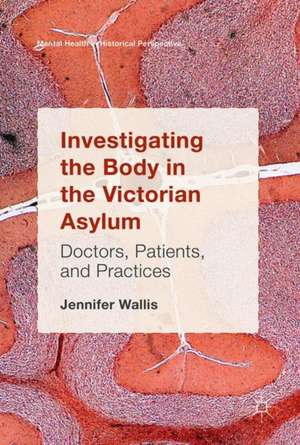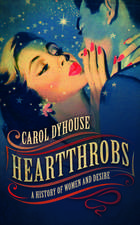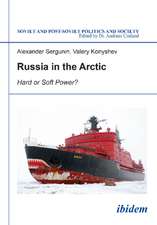Investigating the Body in the Victorian Asylum: Doctors, Patients, and Practices: Mental Health in Historical Perspective
Autor Jennifer Wallisen Limba Engleză Hardback – 24 noi 2017
This book explores how the body was investigated in the late nineteenth-century asylum in Britain. As more and more Victorian asylum doctors looked to the bodily fabric to reveal the ‘truth’ of mental disease, a whole host of techniques and technologies were brought to bear upon the patient's body. These practices encompassed the clinical and the pathological, from testing the patient's reflexes to dissecting the brain.
Investigating the Body in the Victorian Asylum takes a unique approach to the topic, conducting a chapter-by-chapter dissection of the body. It considers how asylum doctors viewed and investigated the skin, muscles, bones, brain, and bodily fluids. The book demonstrates the importance of the body in nineteenth-century psychiatry as well as how the asylum functioned as a site of research, and will be of value to historians of psychiatry, the body, and scientific practice.
| Toate formatele și edițiile | Preț | Express |
|---|---|---|
| Paperback (1) | 154.47 lei 3-5 săpt. | +13.60 lei 7-13 zile |
| Springer International Publishing – 30 aug 2018 | 154.47 lei 3-5 săpt. | +13.60 lei 7-13 zile |
| Hardback (1) | 202.93 lei 39-44 zile | |
| Springer International Publishing – 24 noi 2017 | 202.93 lei 39-44 zile |
Din seria Mental Health in Historical Perspective
-
 Preț: 282.24 lei
Preț: 282.24 lei - 17%
 Preț: 364.29 lei
Preț: 364.29 lei -
 Preț: 148.04 lei
Preț: 148.04 lei -
 Preț: 458.78 lei
Preț: 458.78 lei - 15%
 Preț: 640.24 lei
Preț: 640.24 lei - 18%
 Preț: 727.66 lei
Preț: 727.66 lei -
 Preț: 226.07 lei
Preț: 226.07 lei -
 Preț: 346.86 lei
Preț: 346.86 lei - 15%
 Preț: 523.54 lei
Preț: 523.54 lei -
 Preț: 213.97 lei
Preț: 213.97 lei - 18%
 Preț: 787.47 lei
Preț: 787.47 lei - 15%
 Preț: 446.60 lei
Preț: 446.60 lei - 18%
 Preț: 889.75 lei
Preț: 889.75 lei - 15%
 Preț: 524.22 lei
Preț: 524.22 lei - 18%
 Preț: 786.18 lei
Preț: 786.18 lei -
 Preț: 233.40 lei
Preț: 233.40 lei -
 Preț: 417.90 lei
Preț: 417.90 lei - 15%
 Preț: 701.40 lei
Preț: 701.40 lei - 15%
 Preț: 523.72 lei
Preț: 523.72 lei - 18%
 Preț: 894.34 lei
Preț: 894.34 lei - 15%
 Preț: 504.99 lei
Preț: 504.99 lei - 15%
 Preț: 640.24 lei
Preț: 640.24 lei - 15%
 Preț: 706.30 lei
Preț: 706.30 lei - 15%
 Preț: 576.21 lei
Preț: 576.21 lei - 5%
 Preț: 158.80 lei
Preț: 158.80 lei -
 Preț: 319.98 lei
Preț: 319.98 lei -
 Preț: 227.42 lei
Preț: 227.42 lei
Preț: 202.93 lei
Nou
Puncte Express: 304
Preț estimativ în valută:
38.83€ • 41.52$ • 32.38£
38.83€ • 41.52$ • 32.38£
Carte tipărită la comandă
Livrare economică 14-19 aprilie
Preluare comenzi: 021 569.72.76
Specificații
ISBN-13: 9783319567136
ISBN-10: 3319567136
Pagini: 256
Ilustrații: XVI, 276 p. 9 illus.
Dimensiuni: 148 x 210 mm
Greutate: 0.5 kg
Ediția:1st ed. 2017
Editura: Springer International Publishing
Colecția Palgrave Macmillan
Seria Mental Health in Historical Perspective
Locul publicării:Cham, Switzerland
ISBN-10: 3319567136
Pagini: 256
Ilustrații: XVI, 276 p. 9 illus.
Dimensiuni: 148 x 210 mm
Greutate: 0.5 kg
Ediția:1st ed. 2017
Editura: Springer International Publishing
Colecția Palgrave Macmillan
Seria Mental Health in Historical Perspective
Locul publicării:Cham, Switzerland
Cuprins
Chapter 1: Introduction.- Chapter 2: Skin.- Chapter 3: Muscle.- Chapter 4: Bone.- Chapter 5: Brain.- Chapter 6: Fluid.- Chapter 7: Conclusion.- Appendix: Demographic characteristics of West Riding Lunatic Asylum admissions.
Recenzii
“Investigating the Body in the Victorian Asylum is ultimately more interested in uncovering the scientific questions asylum doctors asked than in assessing the conclusiveness of their answers. … Analyzing these practices with both subtlety and depth, Wallis provides an important historical postmortem of the Victorian asylum ‘as a scientific space’ committed to investigating the body in pursuit of the mind … .” (Athena Vrettos, Victorian Studies, Vol. 62 (4), 2020)
“Investigating the Body in the Victorian Asylum offers a genuine, innovative, and interdisciplinary analysis of the patient’s body within the asylum setting. The rigorous research and the accessible nature of this book together make it a perfect read for anyone, from the undergraduate to the experienced scholar, who is interested in the history of psychiatry in the late nineteenth century and the practice of medical and scientific research at the time.” (Cristiano Turbil, Isis, Vol. 111 (1), 2020)
“Jennifer Wallis’s Investigating Body in the Victorian Asylum: Doctors, Patients, and Practices, part of the Mental Health in Historical Perspective series sets to demonstrate how asylum doctors sought to locate mental illness on the body. … Overall, Wallis’s work provides a fresh, important, and much-needed contribution to the history of psychiatry, the body, and medicine more broadly.” (Lynsey Cullen, H-Net Reviews Humanities and Social Sciences, networks.h-net.org, August, 2018)
“Investigating the Body in the Victorian Asylum offers a genuine, innovative, and interdisciplinary analysis of the patient’s body within the asylum setting. The rigorous research and the accessible nature of this book together make it a perfect read for anyone, from the undergraduate to the experienced scholar, who is interested in the history of psychiatry in the late nineteenth century and the practice of medical and scientific research at the time.” (Cristiano Turbil, Isis, Vol. 111 (1), 2020)
“Jennifer Wallis’s Investigating Body in the Victorian Asylum: Doctors, Patients, and Practices, part of the Mental Health in Historical Perspective series sets to demonstrate how asylum doctors sought to locate mental illness on the body. … Overall, Wallis’s work provides a fresh, important, and much-needed contribution to the history of psychiatry, the body, and medicine more broadly.” (Lynsey Cullen, H-Net Reviews Humanities and Social Sciences, networks.h-net.org, August, 2018)
“Investigating the Body in the Victorian Asylum provides a meticulously researched and thoroughly readable – for all – social history of an important development in the mental sciences in the nineteenth century, centring it around the evolving practices of post-mortem examinations. I particularly like the way in which Wallis writes herself, her research process and her thinking into the book.” (Louise Hide, HHS History of The Human Sciences, histhum.com, August, 2018)
Notă biografică
Jennifer Wallis is Lecturer in Cultural and Intellectual History at Queen Mary University of London, UK, where she teaches courses on the history of psychiatry, the body, and nineteenth-century Britain. Her work has previously been published in History of Psychiatry and Medical Humanities, among others.
Textul de pe ultima copertă
This book is open access under a CC BY 4.0 license.
This book explores how the body was investigated in the late nineteenth-century asylum in Britain. As more and more Victorian asylum doctors looked to the bodily fabric to reveal the ‘truth’ of mental disease, a whole host of techniques and technologies were brought to bear upon the patient's body. These practices encompassed the clinical and the pathological, from testing the patient's reflexes to dissecting the brain.
Investigating the Body in the Victorian Asylum takes a unique approach to the topic, conducting a chapter-by-chapter dissection of the body. It considers how asylum doctors viewed and investigated the skin, muscles, bones, brain, and bodily fluids. The book demonstrates the importance of the body in nineteenth-century psychiatry as well as how the asylum functioned as a site of research, and will be of value to historians of psychiatry, the body, and scientific practice.
This book explores how the body was investigated in the late nineteenth-century asylum in Britain. As more and more Victorian asylum doctors looked to the bodily fabric to reveal the ‘truth’ of mental disease, a whole host of techniques and technologies were brought to bear upon the patient's body. These practices encompassed the clinical and the pathological, from testing the patient's reflexes to dissecting the brain.
Investigating the Body in the Victorian Asylum takes a unique approach to the topic, conducting a chapter-by-chapter dissection of the body. It considers how asylum doctors viewed and investigated the skin, muscles, bones, brain, and bodily fluids. The book demonstrates the importance of the body in nineteenth-century psychiatry as well as how the asylum functioned as a site of research, and will be of value to historians of psychiatry, the body, and scientific practice.
Caracteristici
Received an Honourable Mention in the 2019 European Association for the History of Medicine and Health Book Awards Explores the asylum beyond simply an institution of socio-demographic interest, but also as an experimental space Brings together the history of psychiatry with the history of the body by examining the ways in which the body was investigated within the asylum Utilises an innovative structure mirroring the contemporary process of dissection in the asylum to explore everyday psychiatric practices Includes supplementary material: sn.pub/extras






